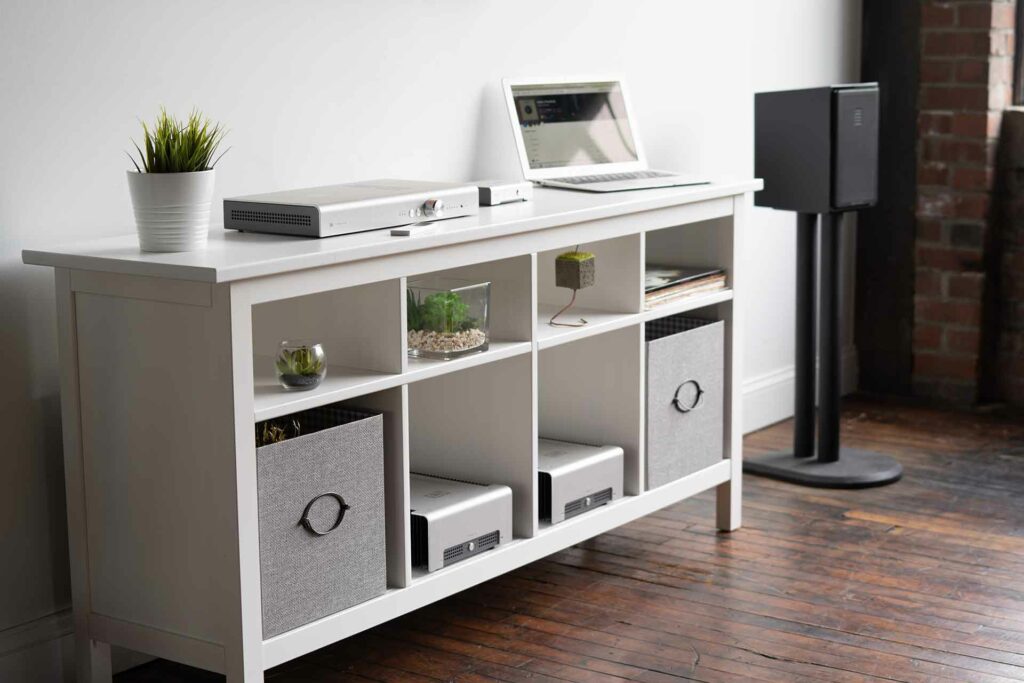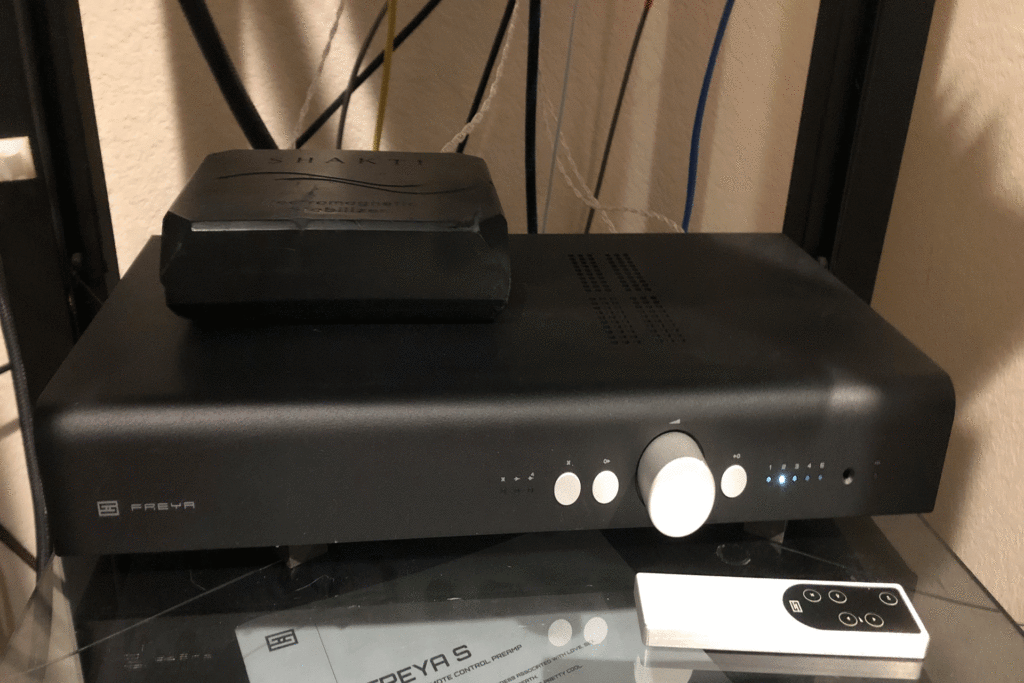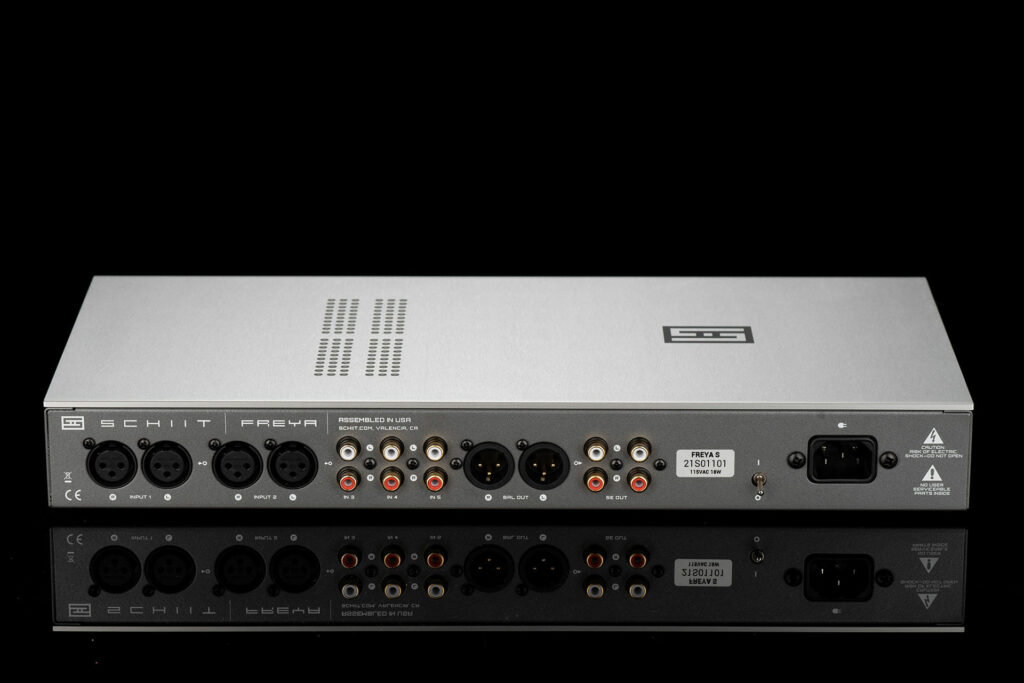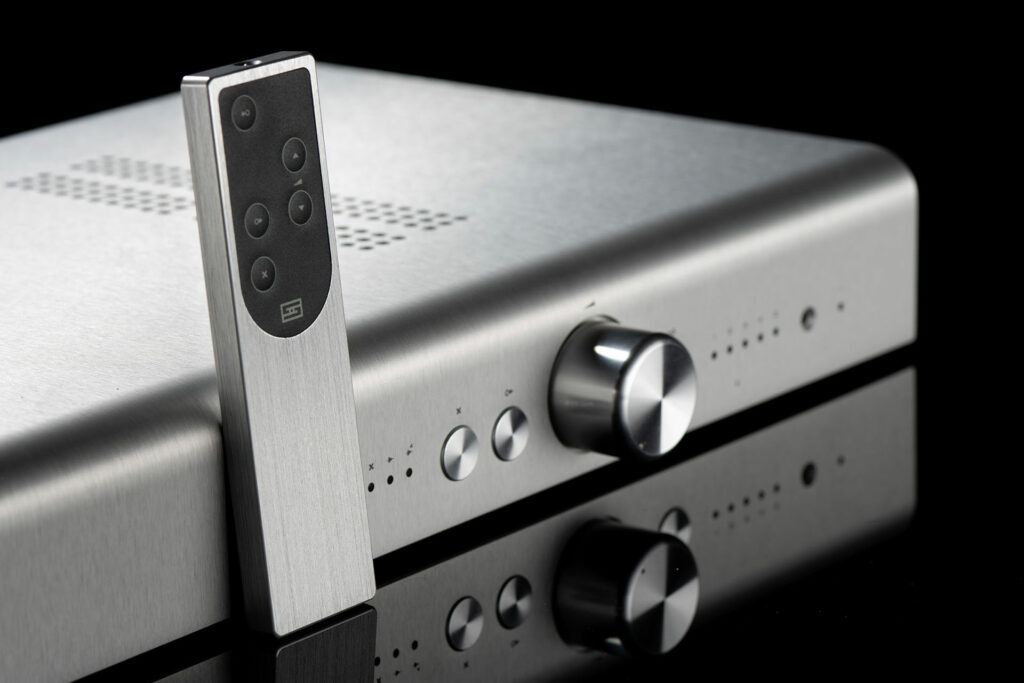Those who know Schiit Audio tend to love them. Putting aside a design legacy that dates back many decades, no audiophile company has a better sense of humor. From outright goofy product names to funny ads to uniquely crafted, very-high-value products – Schiit has built themselves one hell of a following. The Schiit Freya S Stereo Preamplifier is a full function $599 stereo, solid state audiophile preamp that pairs very nicely with the company’s various (and often low-cost) DACs. The units come with a five year warranty and are built in California – which at this price is outright amazing. Schiit gained popularity with their low-cost DACs and this preamp represents the next step in the audio chain for people who want the spine-tingling audio experience but have more of a “Sonos budget”.

What Makes the Schiit Freya S Special?
Believe it or not, you can spend a lot more money on an analog preamplifier and not get any better performance or features than the Schiit Audio Freya S. While there are other preamplifiers in the Freya’s price range that sound perfectly good and others that have most of Freya S’s features but I have yet to find a competitor that has both the sonic performance AND the features offered in the Freya S.

Why Should You Care About The Schiit Freya S Stereo Preamp?
- If you want to use both balanced and unbalanced analog sources and need to send their signals to both a balanced and an unbalanced amplifier, powered speaker, or subwoofer, the Freya S has the necessary inputs and outputs to do that.
- If you have widely varying output levels from your sources the Freya S has three different gain levels. It can be a passive (meaning: buffer only with 0 dB gain) or an active gain stage (with 0 dB gain) or an active stage (with 12 dB of gain). The passive mode sounds completely transparent to me – meaning that I can’t hear any coloration and that is the sign of a very good preamp regardless of cost.
- Unlike most preamplifiers in this price range, instead of a standard “part pot” (off-the-shelf stock part) volume control, the Freya S uses a 128-step resister volume control which is more accurate at keeping the correct balance between channels. I expect this from much more expensive preamps.
- Instead of converting balanced signals to single-ended as most preamps do at this price point – the Freya S is a true differential balanced design that keeps balanced signals balanced throughout. If you need both balanced and single ended from either a balanced or single-ended source, the Freya S can supply both outputs from either source type.

Some Things You Might Not Like About the Schiit Freya S Stereo Preamp…
- The Schiit Freya S’ remote is small, doesn’t light up and uses symbols that may not be easily understood by merely looking at them.
- When you adjust the volume, the Freya S makes clicking sounds. Not distracting to me but you might find it so. Also, it is somewhat tricky to adjust the volume control from the remote in one-step increments. It usually jumps at least two steps up or down.
- The remote control is an IR variety that requires line-of-sight to function properly. RF remotes cost more but work without such close proximity. For those using any kind of control system – prepare to “glue” an IR emitter on the front of your preamp to insure excellent control. For those sitting nearby the preamp – don’t worry – you are all good.
- When you change from 0 dB active to 12 dB active gain the preamplifier will mute for two seconds to give you time to lower the volume control settings. If you do not do that the volume will increase to what could be an uncomfortable level and could even damage your amps or speakers in extreme cases. Just a heads up here.
Listening to the Schiit Freya S Stereo Preamp…
On this video of a live performance by the Band of Heathens has a lifelike “you are there” quality. It also helps that this band is great live. The soundstage through the Freya S is wide and deep with good separation between the performers and the room and PA’s reverb. Tube enthusiasts often rave about the “delicate decay”. Listen to the acapella section at 3:30 specifically… each voice has a unique spot across the soundstage. Unlike many music videos, the sound here doesn’t turn into mush during the loudest (final) chorus.
Haim isn’t a band I listen to regularly but their cover of Fleetwood Mack’s “Oh Well” always energizes me when I watch it. It captures the look and feel of a huge outdoor festival stage and the big sound that comes from a big venue. That guitar lick combined with the mad drumming gets my blood pumping. The crowd noise never intrudes on the music while forming a bed for the musical mayhem. While not super fidelity with subterranean bass, the video does a great job of capturing what must be one of the heaviest guitar/bass riffs ever created.
Moving from videos to a high-definition audio source, Joseph Collier’s “Fix You”, from Qobuz in 96/24 FLAC format would probably sound fantastic through a dixie cup and a string, but through my nearfield rig (currently set up with Audience 1+1 monitors and a Velodyne DD 10+ subwoofer) I can luxuriate in every big piano chord and practically feel each hammer felt hit. And Collier’s voice – unadorned without his usual multi-tracking he has a raw intimacy that can take your breath away.
Does the Schiit Freya S Stereo Preamplifier Have Strong Resale Value?
Yes.
I have seen several Freyas listed on various audio used sites and all were within $150 of their original list price. That is one of the advantages of inexpensive gear… you can’t lose much money on resale because it wasn’t that expensive to start with. Also, analog audio products rarely experience the kind of substantial price drops in their used prices like digital-based components when they are superseded by newer versions with better specifications and features.

Who Is the Competition For The Schiit Audio Freya S?
Given its modest price and abundance of features, the Schiit Freya S has very little direct competition. There’s Schiit’s $399 Saga+ and $299 Saga S, but they both lack provisions for balanced inputs and outputs. If you only have one balanced and one unbalanced input source and a require one balanced and one unbalanced output, the $599 Topping PRE90 could be an option. You can add another box (the $249 EXT90) to gain additional inputs if you require them.
Gustard, another Chinese-based audiophile company that isn’t as well known as Schiit, recently introduced their new flagship preamplifier, the $599 P26. It is also a fully balanced design with a remote – but it does not have as many input options and instead of a dedicated proprietary differential discrete amplifier section it employs op-amps. But even using op-amps the Gustard achieves a 130 dB signal to noise – that’s better than most digital audio convertors.
Another option is the $899 Schiit Freya+. Instead of a transistor-based differential output section of the Freya (S stands for solid-state) the Freya + employs four 6NS7 tubes. It also takes MOSFET tube replacements available from Schiit. The primary disadvantage of the Freya + is that is generates a lot more heat due to the tubes than the Freya S. Also, if you plan to use the passive mode primarily, it is the same circuit for both the Freya S and Freya +, so there is no reason to opt for the +. If you want that “tube sound” it is going to cost you only a few hundred bucks more. Nice.
Final Thoughts On The Schiit Ferya S Preamp…
It used to be that every audio system required an analog preamplifier to select sources and adjust the system’s volume level. Today, with a fully digital audio system – you may or may not need an analog preamplifier. If your digital audio convertor has a volume control and all your sources are digital, it can deliver all the preamplifier functionality you will require.
If you require both analog and digital sources and your DAC does not have any analog inputs (few do) you are going to need an analog preamplifier. I was using a GoldNote DS10+ DAC which has one analog input in my main room reference system. Plugging and unplugging analog sources into it was tedious, so I added the Freya S preamplifier. I now use the DS10+ a fixed output DAC that connects to the Freya S via it balanced XLR connections. With the addition of the Freya S I have one additional balanced and three unbalanced input options.
After conducting a myriad of A/B comparisons and bypass tests with the Freya S in and out of the signal chain, I concluded that I could not hear any differences between when it was part of the signal chain and when it was not, which for me is the definition of a transparent component.
You can spend a lot more for a preamplifier and you may require certain features (like a phase reversal switch or balance control which the Freya + does not offer) but in terms of overall transparency and WYSIWYG sonic performance (especially in passive mode) you will find it extremely difficult to do better sonically or find a better value than a Schiit Freya S.



